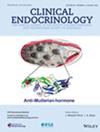Characteristics of bone mineral density in patients with functional hypothalamic amenorrhoea and its association with reproductive hormones and body composition
Abstract
Objective
Bone mineral density (BMD) is typically reduced in patients with female athlete triad (FAT) and anorexia nervosa (AN). However, bone health in most patients with functional hypothalamic amenorrhoea (FHA), who may not suffer from severe energy deficiency, has not received adequate attention in clinical practice. This study aimed to investigate BMD and its association with clinical and endocrine features in individuals with FHA and to provide clinical evidence for improving bone loss and preventing osteoporosis in FHA.
Design
To assess the bone status of patients with FHA and investigate its association with various clinical and endocrinological characteristics.
Patients
We retrospectively analysed 80 patients with FHA who attended the Obstetrics and Gynecology Hospital of Fudan University from January 2022 to March 2023.
Measurements
The levels of reproductive hormones, including luteinising hormone (LH), follicle-stimulating hormone, oestradiol (E2) and total testosterone (TT), were examined at the time of initial diagnosis, and a body composition analyser was used to measure body fat percentage (BF%), lean body mass (LBM) and segmental muscle/fat. Dual-emission X-ray absorptiometry was used to measure lumbar spine BMD and femoral neck BMD in patients with FHA, and the Z score was calculated.
Results
The study cohort consisted of 80 female patients with FHA. The average age of the patients was 24.64 ± 6.02 years, and their body mass index (BMI) was 19.47 ± 2.86 kg/m2. The duration of weight loss was 12 (6, 24) months, while the duration of oligo/amenorrhoea was 12 (4.5, 24) months. The mean degree of weight loss was 18.39 ± 9.53%. Low BMD were present in 15% of patients with FHA at the lumbar spine and/or femoral neck; 12.5% and 10% had low bone mass at the lumbar spine and femoral neck, respectively. The low bone mass group experienced a longer period of weight loss than the normal group [24 (16.5, 60) vs. 12 (4.5, 24) months, p = .037]. In addition, the abnormal group had a lower BMR (basal metabolic rate, BMR) [1158 ± 85 vs. 1231 ± 91 kcal/day, p = .011] and lower bone mineral content [2.15 ± 0.26 vs. 2.43 ± 0.31 kg, p = .009] than the normal group. Both LBMD and femoral neck BMD (Fn BMD) were positively correlated with BMI, BF%, LBM, and regional muscle/fat mass (all p < .05). There was also a positive correlation between LBMD and basal LH levels (p = .009) and waist-to-hip ratio (p = .034), whereas Fn BMD was positively correlated with TT levels (p = .029). Multiple linear regression analysis showed that LBM was positively associated with LBMD (β = .007, 95% confidence interval [CI] = 0.004–0.009, p < .001), while trunk muscle mass was positively associated with Fn BMD (β = .046, 95% CI = 0.013–0.080, p = .008).
Conclusion
Fifteen percent of the patients with FHA exhibited low bone mass, a condition associated with prolonged weight loss. The basal LH and TT levels showed positive correlations with LBMD and Fn BMD, respectively. Meanwhile, BMR levels, BMI, BF%, and muscle mass were all positively correlated with LBMD and Fn BMD. Clinically, we should be attentive to suboptimal bone health in patients with FHA and take early screening, diagnosis and intervention measures, especially appropriate muscle mass gain, to prevent the onset of osteoporosis and fragility fractures in the long term.

| 公司名称 | 产品信息 | 采购帮参考价格 |
|---|
 求助内容:
求助内容: 应助结果提醒方式:
应助结果提醒方式:


